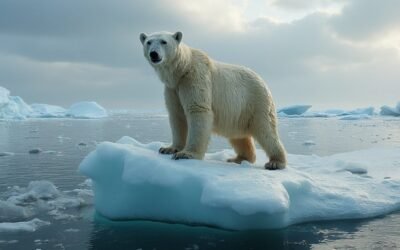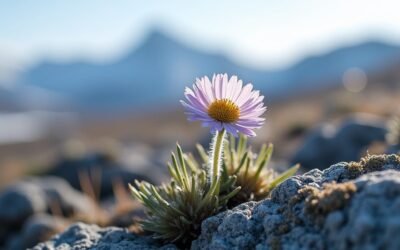Narwhals are crucial to polar ecosystems, acting as apex predators and keystone species. They regulate populations of prey such as fish, squid, and shrimp, contributing greatly to nutrient cycling. Their specialized diet, mainly Greenland halibut and squid, requires diving to great depths. Narwhals' migration patterns align with Arctic sea ice dynamics, ensuring access to food and breeding grounds. Climate change poses significant threats by altering their habitat and prey availability, complemented by risks from pollution and human activity. Conservation efforts, including habitat protection and monitoring, are indispensable. Understanding more about these incredible creatures can reveal deeper ecological insights.
Main Points
- Narwhals act as top predators, regulating populations of fish, squid, and shrimp.
- They serve as keystone marine mammals critical to Arctic marine ecosystems.
- Narwhals contribute to nutrient cycling and distribution in polar waters.
- They act as indicator species, reflecting the overall health of the Arctic ecosystem.
- Their seasonal migrations help maintain ecological balance by following prey distribution and sea ice dynamics.
Narwhals' Ecological Role
Narwhals play an essential role in the polar ecosystem by acting as top predators that help maintain the balance of marine food chains. As a keystone marine mammal in the Arctic, they regulate prey species populations such as fish, squid, and shrimp, thereby preventing ecosystem imbalances. This regulatory function is vital, particularly in the fragile polar ecosystems where even slight disturbances can have cascading effects.
Their migration patterns are another significant aspect of their ecological role. Narwhals traverse vast areas of the Arctic, contributing to nutrient cycling and distribution. This movement facilitates the transfer of nutrients across different marine environments, enhancing overall ecosystem productivity. Moreover, the presence of narwhals is often an indicator of a healthy marine environment, reflecting the stability and productivity of the surrounding ecosystem.
The study of narwhals also provides valuable insights into the impacts of climate change on these delicate environments. As climate change continues to alter the Arctic, understanding how narwhals adapt and respond can offer vital information on broader ecosystem changes. Thus, narwhals not only play a direct role in maintaining marine balance but also serve as important indicators for scientists monitoring the health of polar ecosystems.
Dietary Habits of Narwhals
Understanding the narwhals' dietary habits provides deeper insights into their role as top predators within the Arctic ecosystem. These marine mammals have a specialized diet primarily consisting of Greenland halibut, polar and Arctic cod, shrimp, and squid. These prey items are typically found in the deep waters of their Arctic habitat, highlighting the narwhals' adaptation to their environment.
Narwhals exhibit a unique feeding strategy, diving to significant depths to capture their prey. Their diet is uniquely specialized, relying heavily on specific prey items that are not easily accessible. The following details add depth to our understanding of narwhals' feeding habits:
- Greenland halibut: Ranging from 35-55 cm in length, these fish are a primary food source.
- Polar and Arctic cod: Essential to their diet, these fish are abundant in cold waters.
- Squid: Another critical prey item, often found along the ocean bottom.
- Prey distribution: Changes can impact narwhals' survival, as they depend on the availability of these specific prey items.
The narwhals' reliance on such a specialized diet underscores their sensitivity to shifts in prey distribution. Consequently, understanding these feeding habits is crucial for evaluating their survival prospects within the rapidly changing Arctic environment.
Migration Patterns
The annual migration patterns of narwhals are intricately linked to the seasonal dynamics of Arctic sea ice. These majestic cetaceans navigate the Arctic Ocean by following the ebb and flow of sea ice, moving from dense pack ice in winter to coastal waters during the summer months. This migration is essential for accessing various feeding grounds and breeding areas, ensuring their survival and reproductive success.
| Season | Location | Purpose |
|---|---|---|
| Winter | Dense Pack Ice | Feeding Grounds |
| Spring | Transitional Zones | Migration |
| Summer | Coastal Waters | Breeding Areas |
Narwhals typically travel in pods, which can range from 2 to 10 individuals. These pods are a vital aspect of their migration patterns, as they provide social structures that support navigation and survival. Monitoring these migration patterns is crucial for understanding the population health and conservation status of narwhals, especially in the context of a changing Arctic environment. As sea ice dynamics continue to evolve, so too must our efforts to study and protect these unique creatures, ensuring their role in the Arctic ecosystem remains undisturbed. The insights gained from such studies are invaluable for informing conservation strategies and mitigating the impacts of environmental changes.
Threats to Narwhals
Facing numerous threats in their Arctic habitat, narwhals are increasingly vulnerable due to factors such as climate change, hunting, and human activities. These majestic creatures, known for their distinctive ivory tusks, face a range of challenges that jeopardize their survival.
- Climate change: The rapid reduction in sea ice affects narwhals' habitat and prey availability, disrupting their natural behaviors and feeding patterns.
- Hunting: Traditional hunting by Inuit communities targets narwhals for their ivory tusks and meat, impacting their population despite its cultural and subsistence importance.
- Pollution: Increased human activity, including shipping and industrial operations, introduces pollutants into the Arctic waters, affecting narwhals' health and the overall ecosystem.
- Human activity: Noise pollution from ships and other marine vessels disrupts narwhals' communication and navigation, further stressing these sensitive creatures.
Entrapment due to shifting sea ice movements also poses a critical threat, as narwhals can become trapped and unable to surface for air. Additionally, human-induced changes in the Arctic environment exacerbate these threats, making it increasingly challenging for narwhals to thrive. The combined impact of these factors necessitates urgent attention to safeguard the survival of narwhals in their rapidly changing Arctic habitat.
Conservation Efforts

Given the myriad threats narwhals face in their delicate Arctic environment, collaborative conservation endeavors are crucial to safeguard their future. These endeavors focus on habitat protection from the adverse effects of climate change, hunting, and other human activities. Monitoring populations is a critical component, enabling scientists to track changes in narwhal numbers and health over time. Behavior studies provide essential insights into the species' needs and responses to environmental changes, informing more effective conservation measures.
Cooperative research projects play a pivotal role, involving Indigenous communities, scientists, and government agencies to develop sustainable strategies that strive for the long-term survival of narwhals. These initiatives often aim to mitigate impacts from shipping and noise pollution, which can disrupt narwhal behaviors and migration patterns.
Raising awareness about the importance of narwhals in polar ecosystems is also a key element of conservation efforts. Public education campaigns highlight the significance of protecting these unique creatures and their habitats, fostering a broader understanding and support for conservation measures. By combining scientific research, community involvement, and education, these efforts aim to maintain the ecological balance of the Arctic and ensure a future for narwhals.
Conclusion
Narwhals play an essential role in polar ecosystems through their dietary habits, which influence marine food webs, and their migration patterns, which affect nutrient distribution. However, these marine mammals face significant threats from climate change and human activities. Conservation efforts are vital to mitigate these threats and guarantee the stability of polar ecosystems. Understanding the ecological contributions of narwhals is pivotal for developing effective strategies to protect these unique creatures and maintain the health of their natural habitats.


